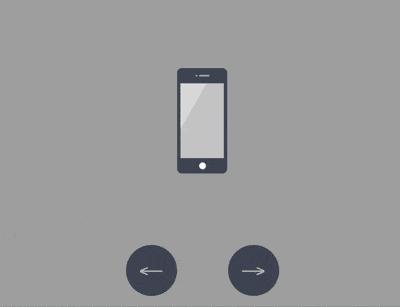如何使用CSS与Vanilla.js完成展示苹果设备的交互动画(附源码)
时间:2024/1/22作者:未知来源:争怎路由网人气:8
- 网页的本质就是超级文本标记语言,通过结合使用其他的Web技术(如:脚本语言、公共网关接口、组件等),可以创造出功能强大的网页。因而,超级文本标记语言是万维网(Web)编程的基础,也就是说万维网是建立在超文本基础之上的。超级文本标记语言之所以称为超文本标记语言,是因为文本中包含了所谓“超级链接”点。本篇文章给大家带来的内容是关于如何用CSS和Vanilla.js实现展示苹果设备的交互动画(附源码),有一定的参考价值,有需要的朋友可以参考一下,希望对你有所帮助。
效果预览

源代码下载
https://github.com/comehope/front-end-daily-challenges
代码解读
定义 dom,包含 5 个子元素,分别代表 iphone, mini, ipad, macbook, imac 这 5 种设备:
<div class="container"> <div class="device iphone"></div> <div class="device mini"></div> <div class="device ipad"></div> <div class="device macbook"></div> <div class="device imac"></div> </div>居中显示:
body { margin: 0; height: 100vh; display: flex; align-items: center; justify-content: center; background-color: #aaa; }设置容器中子元素的布局方式:
.container { position: relative; display: flex; flex-direction: column; align-items: center; }设置设备的共有属性,线性渐变图案将作为屏幕的背景:
.device { box-sizing: border-box; position: relative; display: flex; justify-content: center; background: linear-gradient(120deg, #ddd 30%, #ccc 30%); } .device::before, .device::after { content: ''; position: absolute; }iphone, mini, ipad 的造型相似,都有顶部摄像头、传感器开口和底部按钮,所以这些共有属性可以一起设置,用 ::before 伪元素画出顶部细节,::after 伪元素画出底部按钮:
.iphone::before, .mini::before, .ipad::before { width: 2px; height: 2px; border-style: solid; border-color: #a5adbe; border-width: 0 12px 0 2px; } .iphone::after, .mini::after, .ipad::after { width: 8px; height: 8px; background-color: white; border-radius: 50%; }接下来逐个画出设备。先画出 iphone 的轮廓:
.iphone { width: 59px; height: 124px; border: #484f5e solid; border-width: 18px 4px; border-radius: 6px; }定位 iphone 的顶部和底部细节:
.iphone::before { top: -10px; } .iphone::after { bottom: -13px; }类似地,画出 mini:
.mini { width: 93px; height: 138px; border: #484f5e solid; border-width: 14px 5px; border-radius: 10px; } .mini::before { top: -8px; } .mini::after { bottom: -11px; }再画出 ipad:
.ipad { width: 134px; height: 176px; border: #484f5e solid; border-width: 18px 13px; border-radius: 12px; } .ipad::before { top: -10px; } .ipad::after { bottom: -13px; }接下来画 macbook,先画屏幕:
.macbook { width: 234px; height: 155px; border: 8px solid #484f5e; border-radius: 7px 7px 0 0; }用
::before伪元素画出摄像头:.macbook::before { width: 294px; height: 14px; background-color: #e8ebf0; top: calc(100% + 8px); border-radius: 0 0 14px 14px; }用 ::after 伪元素画出主机:
.macbook::after { width: 3px; height: 3px; background-color: #a5adbe; top: -6px; border-radius: 50%; }接下来画 imac,先画屏幕,屏幕的左、上、右的黑色边框没有用 border 属性画,是因为 border 会在端点处遗留一个斜角,所以改用 box-shadow 实现:
.imac { width: 360px; height: 215px; border-radius: 10px; box-shadow: inset 0 14px #484f5e, inset 14px 0 #484f5e, inset -14px 0 #484f5e; border-bottom: 33px solid #e8ebf1; transform: translateY(14px); }用 ::before 伪元素画出梯形的底座:
.imac::before { width: 90px; height: 0; top: calc(100% + 33px); border: solid transparent; border-bottom-color: #e2e4e8; border-width: 0 10px 47px 10px; }用 ::after 伪元素画出顶部的摄像头和屏幕底部的按钮,注意按钮是用 box-shadow 实现的:
.imac::after { width: 4px; height: 4px; background-color: #a5adbe; top: 5px; border-radius: 50%; box-shadow: 0 191px 0 4px #464e5d; }至此,设备全部绘制完成。
删除除 iphone 之外的其他设备的 dom 元素,只保留 1 个 dom 元素,后面的动画效果都在这个 dom 元素上变化:<div class="container"> <div class="device iphone"></div> <!-- <div class="device mini"></div> <div class="device ipad"></div> <div class="device macbook"></div> <div class="device imac"></div> --> </div>设置容器尺寸,子元素垂直居中,设备的高度占容器高度的 75%:
.container { width: 360px; height: 350px; justify-content: center; } .device { transform: translateY(-25%); }在 dom 中增加 2 个按钮元素,分别用 .left 和 .right 表示:
<div class="container"> <div class="device iphone"></div> <div class="buttons"> <span class="left"></span> <span class="right"></span> </div> </div>定位按钮的位置:
.buttons { position: absolute; width: inherit; font-size: 30px; height: 2em; bottom: 0; display: flex; justify-content: space-around; } .buttons > * { position: relative; width: 4em; }按钮为向左和向右的箭头:
.buttons > *::before { position: absolute; } .buttons .left::before { content: '←'; right: 0; } .buttons .right::before { content: '→'; }设置按钮样式为圆形:
.buttons > *t::before { position: absolute; width: 2em; height: 2em; background-color: #484f5e; color: silver; text-align: center; line-height: 2em; border-radius: 1em; cursor: pointer; }增加鼠标悬停效果:
.buttons > *::before { transition: 0.2s; } .buttons .left:hover::before { width: 4em; content: '?'; } .buttons .right:hover::before { width: 4em; content: '?'; }增加按钮点击效果:
.buttons > *:active { transform: scale(0.9); filter: brightness(0.8); }至此,按钮制作完毕,接下来创建交互脚本。
定义一个获取元素的函数
$:const $ = (className) => document.getElementsByClassName(className)[0]
定义一个存放设备名称的数组:
let devices = ['iphone', 'mini', 'ipad', 'macbook', 'imac']
定义点击行为对数据的加工方法,当点击左侧按钮时,把数组最左边的 1 个元素移到最右边,相反地,当点击右侧按钮时,把数组最右边的 1 个元素移到最左边,这样就可以从 2 个方向循环遍历数组了:
let loop = { 'left': () => devices.unshift(devices.pop()), 'right': () => devices.push(devices.shift()) }定义点击事件,根据数组的变化切换设备:
Array.from($('buttons').children).forEach(element => element.addEventListener('click', function(e) { loop[e.target.className]() $('device').className = 'device ' + devices[0] }) )最后,设置设备切换的缓动效果:
.device, .device::before, .device::after { transition: 0.4s cubic-bezier(0.5, 1.7, 0.5, 1.2); }大功告成!
以上就是如何使用CSS和Vanilla.js实现展示苹果设备的交互动画(附源码)的详细内容,更多请关注php中文网其它相关文章!
网站建设是一个广义的术语,涵盖了许多不同的技能和学科中所使用的生产和维护的网站。
关键词:如何运用CSS与Vanilla.js完成展示苹果设备的交互动画(附源码)